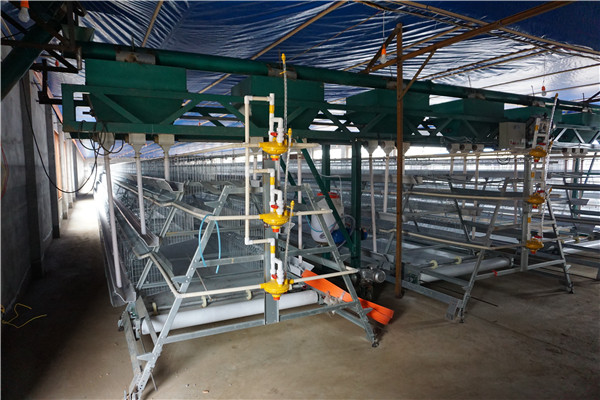In the process of using stacked duck cages to raise egg ducks, farmers need to pay attention to them. Since ducks are all kept in cages, water is a must for fish farmers. Ducks cannot grow without water. Help, in addition to the choice of water source is also very important, then the farmers should choose how to choose the water source, the following Xiao Bian will come to duck some of the water requirements and the main points of introduction. One of the requirements for the selection of water sources is that the amount of water should be sufficient to meet the production and domestic water needs of ducks, ducks, etc., as well as other production water for the duck farms; the second is that the water quality requirements are good and can be met without treatment. Standard water is ideal. In addition, when selecting, it is necessary to investigate whether the local area has experienced some local diseases due to water quality. Third, the water source should be easily protected to ensure that the water source is always in a clean state and is not polluted by the surrounding conditions; the fourth is to require easy access. The investment in equipment is small and the processing technology is simple and easy.
The types of water sources that can be selected for use by the duck farm include surface water, groundwater, and tap water: surface water includes rivers, rivers, lakes, ponds, and reservoirs, etc.: Surface water generally has a wide source, sufficient water, and because it has better The self-purification capability of ducks is the most widely used water source for ducks. However, these waters are mainly composed of precipitation or underground spring water. Their water quality and water quantity are more affected by natural conditions, and they are easily polluted, especially vulnerable to life. Pollution of sewage and industrial wastewater often leads to disease epidemics or chronic poisoning. It is recommended that farmers choose large water sources and use groundwater as a source of water. Ground water
for drinking should generally undergo artificial purification and disinfection.
During the process of duck ducklings raising ducks, the energy feed is an indispensable nutrient substance for growth. The energy feed is the feedstuff with less than 18% crude fiber content and less than 20% crude protein content in the dry matter. Such feeds account for a large proportion of duck diets and are the main source of energy for ducks. There are many kinds of feed ingredients rich in energy. The following small series will introduce several common species to the farmers. Corn: The king of corn is known as feed. It accounts for a large proportion of compound feed and can be as high as 35% to 65%. Its effective energy value is high. The metabolic energy content is 13.50 to 14.04 MJ/kg. Maize is good in palatability and is digested. The high rate is the most used raw material in duck feed, but the protein content of corn is low, only 7.5%-8.7%, the essential amino acids are unbalanced, and the mineral elements and vitamins are lacking. In the compound feed, it is necessary to add other feeds and additives. It is also worth noting that the comminuted corn, if the moisture content is higher than 14%, is susceptible to mold deterioration and should be used in a timely manner. If the corn is stored for a long time, it should not be crushed.
Wheat protein content is more, amino acids than other cereals, vitamin B family is also rich, and easy to digest, so the energy value is second only to corn. The disadvantage is that vitamin A, vitamin D and minerals are less in content and sticky. Wheat raw materials are mainly divided into: barley; wheat; wheat; oats; wheat feed also contains anti-nutritional factor R-glucan and wood Glycans increase the consistency of the digestive tract of ducks, reduce the digestibility of feed nutrients, and even cause diarrhea and other symptoms. The addition of complex enzyme preparations containing R-glucanase and xylanase to the diet is an effective way to increase the feed value of wheat.
Rice, brown rice, and broken rice: The rice crust has a crude fiber content of 9%, crude protein 5%-6%, metabolic energy of about 10.87 megajoules/kg, and the amount of feed should not be excessive, accounting for 10% of the diet. % is appropriate; if pulverized, the content can be appropriately increased to reach 20% to 30% of the diet. After the rice shell is removed, it is brown rice. After brown rice is milled into white rice, it is crushed rice. The energy is high, but the crude protein content is only 1%. When the ingredients are mixed, it can account for 20% to 40% of the grain. Rice is the main energy feed in the rice production area in southern China. Since the application value of brown rice and broken rice to ducks is similar to that of corn, paddy rice and brown rice can be used instead of partially or completely replacing corn feed ducks. Bran: Bran feed is a by-product of grain milling or milling. Its nutritional characteristics are as follows: nitrogen-free extracts have less feed than cereals, crude protein content and quality reside between leguminous seeds and grass seed, high crude fiber and crude fat content, high susceptibility to rancidity, and high phosphorus content in minerals. In the form of phytate, the calcium and phosphorus ratios are not balanced. In addition, the drums are widely sourced, soft and palatable. The raw materials that are rich in bran are: wheat bran, rice bran, roots, tubers and melons; potatoes; sugar beets; pumpkins; and carrots.
























